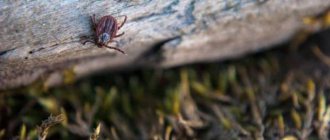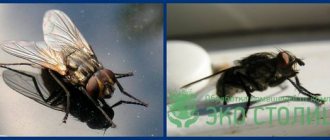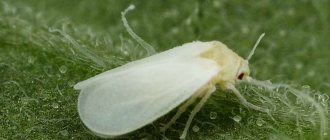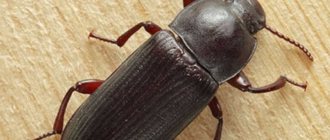Moose flea (moose bloodsucker, tick, fly, louse) are blood-sucking parasites. They feed on blood. The main hosts or feeders are artiodactyls. They can parasitize wild animals, cattle, and birds. When the parasites multiply strongly in nature, they attack people. Once on the body of the host, they shed their wings and become like a flea or tick. Eggs and larvae develop in the female’s body and are born as prepupae. They fall to the ground, complete the cycle, and turn into an adult insect.
What does a moose flea look like, photo
The hybrid creature looks like a fly, flea, lice, or tick. Sexually mature juveniles have wings, but use them only to land on the body of an animal or person. During this period, the parasite looks like a fly. Once in the right place, the pest gets rid of its wings and becomes similar to other common bloodsuckers.
The body is flattened, with dense covers, light brown in color. The size of the winged individual reaches 3.5 mm. There are small antennae on the head and huge eyes. The mouthparts are piercing-sucking, with a proboscis like that of a jig fly. Well developed, strong legs with asymmetrical claws. The integument is elastic; during feeding and pregnancy, the abdomen easily increases in size.
Bloodsuckers are viviparous; only one larva appears at a time. It falls to the ground, pupates, and turns into an imago. The ability to mate appears after the insect has received a portion of blood.
Prevention
To protect yourself from deer fleas, you need to follow the following preventive measures:
- You should not visit the forest during the period when insects are active, which usually occurs at the end of summer and beginning of autumn.
- Choose suitable clothing. It should be as closed as possible and made of dense fabrics.
- Use repellent before going into the forest. Use them not only on skin, but also on clothes and accessories.
- It has been proven that deer fleas can attack humans only during daylight hours, since they are to a certain extent guided by vision when choosing a victim. Therefore, if you avoid walking in the forest during the day, you can protect yourself from parasites.
- Hunters are at particular risk. Cases of mass attacks on humans are often recorded during the cutting of artiodactyl animal carcasses, so it is advisable to be fully armed during such a procedure. To do this, put on a mosquito net, protective suit and gloves in advance.
Now if you encounter deer fleas, you will know how to get rid of them. But it’s better to worry about protection in advance and follow preventive measures.
The danger of moose fleas to humans
Parasite attacks are widespread. At the same time, it rushes to attack up to 120 pieces per minute, but more often the bloodsuckers crawl onto the human body in pairs of several pieces. Hunters, visitors to forests, fields, and shepherds become victims. Parasites choose a large victim, so if a child is near an adult, he will not be harmed; parasites do not attack children under 8 years of age. They are active during the day. They lie in wait for prey in tall grass, on the lower branches of bushes and young trees.
The bloodsucker sits motionless on a person for several minutes, then quickly rises up to the hair, or climbs under clothes. The fly is not frightened by sudden movements; it clings to the skin with its claws and holds on tightly. Having chosen a favorable place, the fly attaches itself immediately or after a few hours, depending on how hungry it is. The behavior of the bloodsucker resembles a tick, with the only difference being that it does not stick its head under the skin.
Bloodsuckers in the wild feed on the blood of animals that spread Lyme disease and borreliosis. In laboratory studies, the infectious agents were found in 30% of hungry moose flies with wings. In most cases, dermatitis, inflammation, eczema, and an allergic reaction develop at the site of the bite.
Methods for controlling moose ticks
How to deal with bloodsucker? There are several effective methods - industrial and folk.
Terrain processing
Powerful insecticides are used to treat the area. Samples of the first generation caused irreparable harm not only to mites, but also to trees, so they were used only when absolutely necessary. But modern products are absolutely safe for people, indoor plants and pets.
Spraying of chemicals occurs using a special device that breaks down insecticides to the consistency of cold gas. Such steam generators guarantee that poison gets into hard-to-reach areas. At the final stage, hot steam treatment is performed, which does not leave the slightest chance for parasites.
Room treatment
To remove moose ticks from indoors, use liquid carbon dioxide cooled to -50 degrees. No living creature can survive in such cold.
Regular mowing
To protect summer cottages from moose bloodsuckers, you need to mow the grass more often. It is in dense and tall thickets that they most often appear.
Moose ticks, like many other insects, love to live in thick grass, so you need to keep your lawn mowed regularly.
Spraying lawns
Experts advise regularly spraying lawns and trees with ordinary water - ticks hate moisture. To be safe, add alcohol and crushed garlic, a decoction of tansy and wormwood. Planting wormwood or tansy in areas where elk flies are permanent habitats is also suitable.
Using repellents
Before going into the forest, apply a strong repellent that contains DET to your clothing. They have a repellent effect and will not allow ticks to get to the distance you need to jump. An alternative to store-bought products is a bath or shower with tar soap foam.
See also: Moose fly - why it is dangerous and how to fight it (video)
Symptoms of bites
The sensations differ from person to person; some consider them unnoticeable, others consider them painful. While feeding, the bloodsucker injects a substance that reduces blood clotting. Saliva contains allergens, so after a few minutes redness, itching, and burning appear. In people who are annually attacked by moose flies, the reaction is stronger, the bites are more painful, and the consequences are more severe. Individual intolerance and sensitivity of the skin are also of great importance.
Different reaction:
- At first the bite is almost unnoticeable, but after a few days thickening and redness appear. The papule lasts up to 20 days and is accompanied by itching and burning.
- A red spot forms without swelling, then a red ring appears. After a few days, the victim begins to experience severe itching day and night.
- After the bites, a rash appears that disappears within 5 days.
- A papular rash with itching and crusts lasts up to 12 days.
- 1 hour after the bloodsucker feeds, blisters, redness, and inflammation appear.
- People who are bitten by elk lice every year develop a red papule and erythema after the bite. Treatment lasts up to 6 months.
When scratching, an infection gets into the wound, eczema and ulcers appear.
Treatment
The choice of remedies depends on the severity of the symptoms. If the body’s reaction is normal, people can use folk remedies, pharmaceutical drugs that eliminate inflammation and relieve itching. If there are obvious signs of allergies, antihistamines and antiallergic drugs are used. If a secondary infection develops, local antibiotics are used.
Folk remedies:
- ice cubes;
- cold water;
- toothpaste;
- shaving foam;
- soda paste;
- saliva;
- vodka;
- lemon juice, potato, cucumber.
Pharmaceutical drugs:
- alcohol;
- Menovazin;
- tincture of calendula, valerian, hawthorn, motherwort;
- Calendula ointment;
- balm Zvezdochka;
- Bepanten;
- Boro-Plus;
- Rescuer.
Antihistamines, antiallergic medications:
- Psilo-Balm;
- Advantan;
- Betamethasone;
- Fenistil-gel;
- Elokom;
- Dermovate;
- Fluorocort.
Local antibiotics:
- Vishnevsky ointment;
- Levomekol;
- Tetracycline ointment;
- Elokom with salicylic acid.
When infected with Lyme disease, your health worsens, signs of intoxication appear, and a huge red spot forms at the site of the bite. Treatment is carried out with antibiotics, prescribed by a specialist, therapy is carried out under the supervision of doctors.
Deer, moose bloodsucker in the apartment
The parasite appears in a person’s home after visiting a forest, field, or pasture. Initially, the louse clings to clothing and makes its way to the hair and open areas of the body. If the insect falls down before it can settle on the body, there is a possibility of a bite already in the apartment; if the bloodsucker falls after it has eaten, a second bite is rare. The pest will not be able to reproduce at home, since it gives birth to only one larva, and it needs soil for further transformation. Even if the parasite goes unnoticed, at home it will die after some time.
Moose lice on a person
The bloodsucker attacks people, but requires the blood of an animal to procreate. It chooses humans as a source of nutrition only during prolonged fasting in order to replenish energy. The parasite soon disappears after saturation and does not live on the body.
To prevent bites, you should follow safety precautions and use repellents. Aerosols, sprays, solutions based on broad-spectrum insecticides are used, as well as folk remedies - cologne, vanillin, essential oils. When going to dangerous places, you should wear a hat, tuck your trousers into your socks, and choose a trunk with cuffs. Upon returning home, throw your clothes in the wash, have a good look at your body, and take a shower.
If you find moose flea bites on your body, you need to treat them with agents with anti-inflammatory, antipruritic, and regenerating effects. If the condition does not return to normal within 3 days, you should contact a specialist.
How to protect yourself from moose lice in the forest?
Now you know that moose fleas are dangerous to humans, so a trip to the forest should be carefully considered. Experts recommend:
- wear clothing that covers the entire body;
- the trouser legs, cuffs and collar must fit tightly, otherwise the moose fly, which we described above as a dangerous bloodsucker, will crawl into the holes towards the body;
- treat your hands, face, and neck with repellents. Typically, moose lice treatment is made with DET;
- apply repellent to clothing. If you have any difficulties purchasing a ready-made repellent, you can use regular tar soap. This remedy for moose lice in the forest will save you no less effectively;
- Bring with you special tools for removing ticks - a lasso handle, a tick gun or an ordinary strong thread. After physically feeling the bite, you need to try to remove the blood-sucking fly as carefully as possible by pulling its proboscis out of the body;
- take hydrogen peroxide and iodine, hand sanitizers and an antihistamine for moose flies in your backpack - the person providing assistance also sanitizes the hands.
Removing the insect will not be easy. It must be remembered that a flat fly is a sticky one, having a body structure in which classical physical methods of fighting do not work. If there is no confidence that the ectoparasite will be correctly extracted, you need to use oily substances. If complications are detected, consult a doctor immediately. It often happens that a moose fly is found in an apartment. In this case, you need to try to drive it out or scare it off with repellent.
Reviews
Dear readers, was this article helpful? What do you think about the moose flea (moose bloodsucker). Leave feedback in the comments! Your opinion is important to us!
Anton
“Last summer there was an invasion of bloodsuckers in our region. It was impossible to be in the forest, near the swamp. They attack worse than midges. The bite hurts, and the itching is just terrible! Repellents do not help, clothing protects, but even then not always. The neck suffers the most. From my observations, I noticed that they attack more if a person is sweating, actively moving, and if you walk calmly through the forest, trouble can be avoided.”
Stas
“In our area, only a good mosquito suit helps, there is no need to come up with anything else. Shepherds and hunters always wear this equipment. No other way!"
Protection against moose fly bites
It will be quite difficult to avoid an attack by an elk fly in the forest. As soon as they sense a person nearby, they immediately attack.
First of all, in the forest you must use a mosquito net and wear clothing that covers your body, or use special repellents.
Repellents in aerosol form allow you to apply the product evenly to all exposed parts of the body.
There are no active repellents that can completely protect a person from an elk fly attack, so it is imperative to wear special clothing. Moose flies are active mainly in the autumn season, so wearing protective clothing will not make a person too hot and uncomfortable.
You can also wear regular clothing instead of protective coveralls. The shirt will need to be properly tucked into the trousers, and the trouser legs into the boots or long socks with an elastic band. In this case, you need to fasten the collar and put a hat or scarf on your head. Clothing should be carefully examined after arriving home to check for the presence of deer bloodsuckers. For more information about fighting flies, watch this useful video:
https://youtube.com/watch?v=qr8XZ0_wQ2A
It is better to go into the forest together and, if possible, check each other for the presence of bloodsuckers and other possible parasites. In addition to moose flies, other, more dangerous pests can attack a person, and by carrying out an inspection in a timely manner, you can avoid undesirable consequences in the future.
After returning home from the forest, it is best to immediately take a warm bath and wash with tar soap, which will help wash the bloodsucker off the body.











